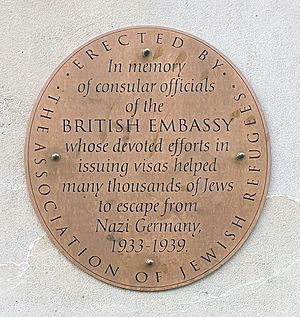Margaret Reid (intelligence officer) facts for kids
Margaret Grant Reid MBE (born August 2, 1912, in Nottingham; died April 20, 1974, in Nottingham) was a brave British intelligence officer. She also worked as a consular official in Berlin and Norway. She received an award called the MBE for her important work during the 1940 German invasion of Norway. Margaret Reid was also given the British Hero of the Holocaust award after her death. This was because, in 1938 and 1939, she helped save many Jewish lives. She did this by giving people special documents that allowed them to leave Nazi Germany.
Contents
Early Life and Education
Margaret Reid was born in Nottingham on August 2, 1912. Her father, Alexander Christie Reid, was a surgeon. Margaret went to Nottingham Girls' High School. Later, she studied modern languages at Girton College, Cambridge. She finished her studies and graduated in 1934.
Helping People in Berlin (1938–1939)
After college, Margaret Reid joined the British government service, called the Civil Service. In 1938, she was sent to the British Embassy in Berlin. She worked in the passport control office there, under a man named Frank Foley.
Margaret arrived in Berlin right after an event called Kristallnacht in November 1938. This was a terrible time for Jewish people in Germany. The passport office became very busy. Many Jewish families wanted to leave Germany and needed visas. The embassy's passport office helped thousands of Jewish people get visas to emigrate. Margaret Reid often bent the rules to help people get these visas. The British Consul-General, George Ogilvie-Forbes, knew she was doing this and deliberately allowed it. This helped save many lives.
Working During the War in Norway (1939–1940)
In September 1939, the United Kingdom declared war on Germany. Margaret Reid and Frank Foley were then moved to the British Legation in Oslo, Norway.
In April 1940, Germany invaded Norway. Foley, who was the first secretary, and Reid, his private secretary and cipher clerk, had to leave Oslo. They traveled to Lillehammer and Åndalsnes. Before leaving Oslo, Foley and Reid burned all the important documents at the UK legation.
Frank Foley had a special radio transmitter. This allowed Norway's commander-in-chief, General Otto Ruge, to talk to London. This was important because it worked even if the regular phone lines were down. Margaret Reid was an expert at coding messages. She used a special book cipher based on an old book to send secret messages to Britain. On May 1, Foley and Reid were safely taken away by the Royal Navy from Molde on a ship called HMT Ulster Prince.
Margaret Reid was later given the Member of the Most Excellent Order of the British Empire (MBE) award. This was for her "gallantry and devotion to duty" during the evacuation from Norway. She also received Norway's own Krigsmedaljen (War Medal). Her personal journal from the time she spent in Norway is kept at the Imperial War Museum. It was even published in Norway in 1980.
Later Life and Important Recognition
In 1942, Margaret married Lt Col. Edward Cuthbert de Renzy Martin. He was also involved in intelligence work. Both Margaret and Edward passed away in 1974.
In January 2018, Margaret Reid and George Ogilvie-Forbes were both given the British Hero of the Holocaust award. This award recognized their incredible bravery in saving Jewish lives during the Holocaust. Frank Foley, who worked with Margaret, was one of the first people to receive this award in 2010. On May 12, 2020, the Association of Jewish Refugees put up a special plaque. This plaque honors the consular officials at the British Embassy in Berlin who helped so many people.


